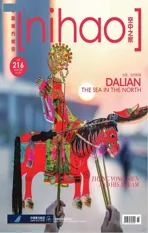墨西哥迷与情
2017-06-12
墨西哥迷与情
墨西哥是一个距中国非常遥远的国家,这个距离曾造成我们之间的了解不是那么多。但事实上,早在16世纪的时候,中国和墨西哥之间就有交往了。而随着两地航班的增多,我终于有机会来到这个迷人的国度,体会它的热情与神秘。



Multi Civilisations
After arriving in Mexico City, I got accommodation near Plaza de la Constitución. This is the third largest plaza in the world. On the east side of the Plaza is Palacio Nacional, while on the north side stands the biggest Cathedral in Latin America. Overlooking the modern Mexico City from the top of a Cathedral with hundreds of years' history, I saw all kinds of light coloured houses built from the foot of the mountain along to halfway up the hill. The Jesus sculpture on the top of the mountain is there looking down over the living beings in this city.
For anyone visiting Mexico City, Piramide de Sol and Piramide de la Luna are places which cannot be missed. Piramide de la Luna was built around in BC. 300, located in northern Pre-Hispanic City of Teotihuacan. Piramide de Sol, which is the biggest architecture in Pre-Hispanic City of Teotihuacan was built around in AD 100. Its volume reaches 1 million cubic metres, which equals roughly the volume of Khufu Pyramid in Egypt. The four sides of the tower are designed as equilateral triangles. The ratio of the base and the height are exactly the ratio of the circumference and the radius. What connects Piramide de Sol and Piramide de la Luna is so called Death Avenue. One saying is that it was named by Aztecs, for they believed that both pyramids were the tombs of their ancestors. Another saying tells it was named by Spanish people, because they saw the pyramids in Egypt and thought that all pyramids were tombs. But later,these two pyramids were proved to be used for sacrif i cial ceremony or for divination.

Piramide de Sol and Piramide de la Luna are identities of the Teotihuacan civilisation. Mexico, like China, has a long history, among which several civilisations have taken turns. Some faded and were not able to be completely written into history or recorded into fi les, so today Mexican history looks so lost and mysterious. However, even if in the most simplif i ed chronology, it's not diff i cult to see the important position of the Teotihuacan civilisation as a connecting link between the preceding and the following. It inherits the essence of the Olmec Civilisation. Mexican of this era loved to build overvolumed architecture. Two of three largest scaled pyramids in the world were built, among them is Piramide de Sol.
Great Temple by the Aztec is another historical spot that is located in the Plaza de las Tres Culturas , the Tlatelolc District in the north of the city. There are three groups of architecture: the grand alter ruins of Aztec Pyramid, the church built by Spanish colonists in the 16th and 17th centuries and the building of Mexican Ministry of Foreign Affairs built in 1950s. The three groups of buildings can represent three cultures in Mexico, the Aztec Civilisation of ancient Indians, European Culture brought by Spanish colonists and modern Mexican Culture. They appear wonderfully together on a plaza and become the image of Mexican nations and history.

The land of corn
“The corn is the base and roots of Mexican culture, also the symbol of the country, the endless inspiration for us. We created corn, and corn cultivates us“, said the Mexicans.
As history proved, corn originated 5000 years ago from a kind of wild millet in the Balsas River valley of Michoacán. The ancient Maya living in Mexico divided one year into nine seasons according to the position of the sun and the farming of the corn. The second season called “ripe“, at around the beginning of August, is the harvest and celebration season for people after one year's work. They harvest the fresh corn and hold some specif i c religious ceremonies and festivals. The Mexicans also created the Maya and Aztec civilisations during the process of corn farming. There are also many myths and folklores about the corn. Among the gods of the ancient Indians are also some gods of corn.
Nowadays, the Mexicans have developed a leading edge technology of corn farming and processing. The Mexicans fi rst cultivated and popularised colourful corn in shades of navy blue, dark green, violet, red, yellow, blue, white, and green. In supermarkets, all kinds of corn can really amaze people. The corn was regarded as the main food of the ancient Indians. Now, the Mexicans regard the taco as a main course. The Mexicans also specially set the last week of July as their national holiday, the corn festival, and hold a grand ceremony to commemorate their ancestors' great contribution of discovering the corn. During the corn festival, people dance and sing as much as they want, taste corn ice-cream, corn wine and various corn foods, such as burritos, nachos, quesadillas, tortillas, the most traditional tacos and so on. The festival can also be seen as an Expo of corn foods, where tourists can taste all kinds of corn.




交错的文明
到达墨西哥城后,我住在宪法广场附近。宪法广场是世界上最大的广场之一,它的东侧是国民宫,北边是拉丁美洲最大的天主教堂。从有几百年历史的教堂顶上眺望现代化的墨西哥城,各种色彩鲜艳的房子一路从山脚建到了半山腰。而在山顶的是一座耶稣雕像,仿佛在俯视着这座城里的众生。
来到墨西哥城,太阳金字塔和月亮金字塔是必不会错过的代表性景点。月亮金字塔约建成于公元300年,位于特奥蒂瓦坎国家公园北部。太阳金字塔约建成于公元100年,是整个特奥蒂瓦坎国家公园中最大的建筑。它的体积达100万立方米,和埃及的胡夫金字塔体积大体相等,塔的四面也都是呈“金”字的等边三角形,底边与塔高之比,恰好也等于圆周与半径之比。而将太阳金字塔与月亮金字塔连接起来的就是传说中的亡灵大道了。关于这个名字,一种说法是阿兹特克人起的,因为他们相信大道两边的金字塔都是先人的陵墓。另一种说法是这个名字是西班牙人起的,由于西班牙人见过古埃及的金字塔,认为所有金字塔都是陵墓,于是把这条金字塔群中的大道如此命名。但后来证明这些金字塔其实是祭祀或占卜测量用的。
太阳金字塔和月亮金字塔是特奥蒂瓦坎文明代表性遗址。墨西哥拥有悠久的历史,曾出现过数个文明的更替,一些消失的文明没有被完整地记录下来,因而整个墨西哥的历史显得失落而神秘。即使在这个极简版纪元表里,也不难看出特奥蒂瓦坎文明承上启下的重要位置,她继承了奥尔梅克文明最为精髓的部分。这个时期的“墨西哥人”喜欢建造体量超群的建筑,世界上规模最大的三大金字塔有两个是他们造的(埃及只占一个),其中的代表就有太阳金字塔。
阿兹特克大神庙遗址是墨西哥城另一处著名历史胜地,它坐落在城东北部特拉特洛尔科区的“三文化广场”。广场上有三组不同时代的建筑物:阿兹特克大神庙遗址、16―17世纪西班牙殖民者修建的教堂以及20世纪50年代建造的墨西哥外交部大厦。这三种建筑代表了三种文化,即古代印第安人的阿兹特克文化、西班牙殖民者带来的欧洲文化以及墨西哥现代文化。它们奇妙地共存于一个广场上,成为墨西哥民族和国家历史的浓缩。
玉米的国度
“玉米是墨西哥文化的根基,是墨西哥的象征,是我们无穷无尽的灵感的源泉。我们创造了玉米,玉米又造就了我们。”墨西哥人这样说。
现代考古证实,玉米起源于一种生长在5000年前墨西哥米切肯州巴尔萨河流域的野生黍类。历史上生活在墨西哥的古代玛雅人,根据太阳的位置和玉米的种植将一年划分为9个节气。在第二个叫作“成熟”的节气,大约8月初,是人们辛苦一年后开始收获和欢庆的日子。人们收获鲜嫩的玉米,举行一些特定的宗教仪式和欢庆活动。墨西哥人还在种植玉米的过程中创造出了玛雅文明和阿兹特克文明。墨西哥民间有许多关于玉米的神话和传说,古代印第安人信奉的诸神中,也有好几位玉米神。
现在的墨西哥人对玉米的种植和加工技术可以说是已经发展到了极致。墨西哥人最先培育并推广了彩色玉米,有深蓝色、墨绿色、紫红色,还有红、黄、蓝、白、绿各色间杂的五彩玉米。超市货架上,种类繁多的玉米食品足以让人为之瞠目。玉米原是印第安人的主要食粮,现代墨西哥人仍以玉米饼为主食。古代墨西哥人还专门设有“玉米节”,每年7月的最后一个星期,都要举行盛大的庆祝活动,纪念祖先为人类发现玉米的伟大功绩。“玉米节”期间,人们尽情地唱歌跳舞,品尝着玉米冰淇淋、玉米酒及各种各样的玉米食品,如玉米卷饼、玉米馅饼、玉米粽子、炸玉米合、煎玉米饺,以及传统的玉米饼“塔哥”等。这个节日也可称为墨西哥玉米食品展览会,游客们可以一次性将玉米美食“一网打尽”。


On April 10, 2017, China Southern Airlines launched a new service fromGuangzhou to Mexico City via Vancouver, operated by the Boeing 787 Dreamliner. This is China Southern's first flight to Latin America. If you log onto China Southern Airlines official website, APP or WeChat, you can search the keyword “Mexico City” to gain access to extremely great deals during the promotion period (April to June).
2017年4月11日,南航开通广州—温哥华—墨西哥城航线。这是南航第一条飞往拉丁美洲的航线,由梦想飞机波音787执飞。在南航官网、APP或者微信公众号打开“南航假期”,搜索“墨西哥城”,就可以看到推广期(4月到6月)极其优惠的打包产品。
